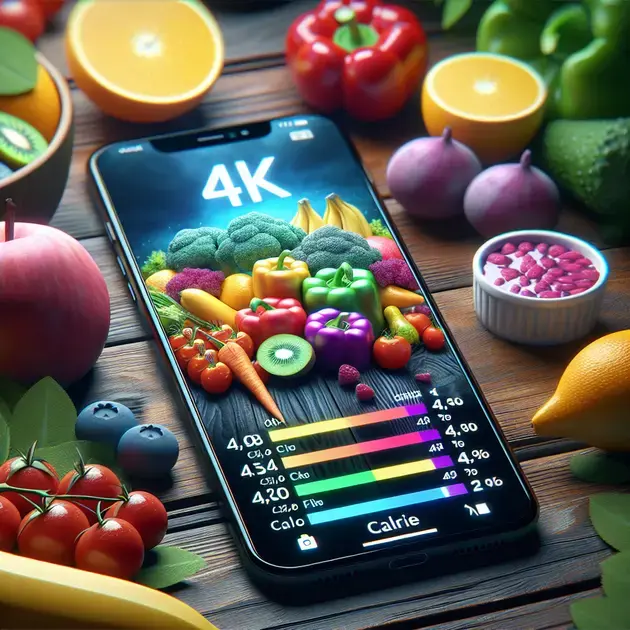
Are you looking to shed some extra pounds and optimize your calorie intake for weight loss? In this simple guide, we will explore the most effective strategies to help you achieve your weight loss goals.
Recent studies have shown that by carefully monitoring and adjusting your daily calorie intake, you can significantly improve your chances of successful weight loss. By following the tips outlined in this guide, you can make informed decisions about your diet and ultimately reach your desired weight.

Optimizing Your Calorie Intake for Weight Loss: The Basics
When it comes to optimizing your calorie intake for weight loss, the first step is to determine your daily caloric needs. You can use online tools such as MyFitnessPal or Lose It! to calculate your basal metabolic rate (BMR) and estimate the number of calories you need to consume to maintain, lose, or gain weight.
Once you have your daily calorie target, the next step is to focus on the quality of the calories you consume. Prioritize whole foods such as fruits, vegetables, lean proteins, and whole grains over processed foods. These nutrient-dense options will not only help you stay within your calorie limit but also provide essential vitamins and minerals for overall health.
Tracking your calorie intake is crucial for weight loss success. Using apps like MyPlate or Cronometer can help you monitor your daily food consumption and ensure you are staying on track with your calorie goals. Remember to log everything you eat and drink, including snacks and beverages, to get an accurate picture of your calorie intake.
In addition to monitoring your caloric intake, staying hydrated is essential for weight loss. Drinking water throughout the day can help control hunger and prevent overeating. Aim to consume at least 8 glasses of water daily and consider using apps like Waterlogged to track your water intake and stay hydrated.
Lastly, be mindful of portion sizes to avoid exceeding your calorie limit. Using tools like measuring cups, food scales, or visual guides can help you accurately portion out your meals and snacks. Being aware of serving sizes and practicing portion control can make a significant difference in managing your calorie intake for weight loss.
Understanding Calorie Tracking and Its Impact on Weight Loss
Calorie tracking plays a vital role in weight loss by creating awareness of your food choices and helping you stay accountable to your goals. Apps like MyFitnessPal or Fitbit allow you to log your meals and snacks, track your exercise, and monitor your progress towards your target calorie intake.
How to Track Your Calories:
Start by recording everything you eat and drink throughout the day, including portion sizes. Use the barcode scanner feature in apps like Lose It! or Yazio to quickly input nutritional information from packaged foods. Be honest and accurate in your tracking to get the most benefit from calorie tracking.
The Impact of Calorie Tracking:
By consistently tracking your calories, you can identify patterns in your eating habits, pinpoint areas for improvement, and make necessary adjustments to reach your weight loss goals. Seeing your daily calorie consumption visualized can motivate you to make healthier choices and stay within your target range.
Setting Realistic Goals:
Understanding the relationship between calorie intake and weight loss can help you set realistic goals and make sustainable changes to your diet. Apps like Noom or SparkPeople offer personalized goal setting and guidance based on your individual needs and preferences.
Staying Consistent:
Consistency is key when it comes to calorie tracking and weight loss. Make it a habit to log your meals and snacks regularly, even on weekends or special occasions. Over time, consistent tracking will become second nature, making it easier to maintain a healthy calorie intake for long-term success.
Practical Tips for Adjusting Your Daily Calorie Intake
Adjusting your daily calorie intake for weight loss requires a strategic approach to ensure sustainable results. Consider consulting with a registered dietitian or nutritionist to determine the appropriate calorie deficit for your goals and lifestyle. These professionals can provide personalized recommendations and support to help you succeed.
When reducing your calorie intake, focus on making gradual changes to prevent feeling deprived or overwhelmed. Start by cutting back on high-calorie beverages like sugary sodas and juices, and replacing them with water, herbal tea, or sparkling water. Simple swaps like this can significantly impact your daily calorie consumption.
Incorporating more fiber-rich foods into your diet can help you feel fuller for longer and support your weight loss efforts. Foods like legumes, whole grains, fruits, and vegetables are excellent sources of fiber and can aid in regulating hunger and appetite. Apps like Fiber Rich Foods can help you identify fiber-packed options for your meals.
Don’t forget to prioritize regular physical activity alongside adjusting your calorie intake. Combining a balanced diet with exercise can enhance weight loss results and improve overall health. Utilize fitness apps like MyFitnessPal or Nike Training Club to track your workouts and monitor your calorie expenditure to complement your adjusted calorie intake.
Remember that weight loss is a gradual process, and it’s essential to be patient and persistent in your efforts. Celebrate small victories along the way, stay motivated, and seek support from friends, family, or online communities to stay accountable and inspired on your weight loss journey.

Optimizing Your Calorie Intake for Weight Loss: The Next Steps
When it comes to weight loss, optimizing your calorie intake is essential for achieving your goals. One of the next steps you can take is to focus on nutrient-dense foods that will help you feel satisfied while managing your caloric intake. Incorporating plenty of fruits, vegetables, lean proteins, and whole grains into your diet can provide essential vitamins and minerals without excess calories.
Another important factor in optimizing your calorie intake for weight loss is portion control. Be mindful of serving sizes and consider using measuring cups or a food scale to accurately track your intake. This can help prevent overeating and ensure you stay within your calorie goals.
Additionally, paying attention to your eating habits and mindfulness can play a significant role in optimizing your calorie intake. Eating slowly, savoring each bite, and listening to your body’s hunger cues can help prevent mindless snacking and unnecessary calorie consumption.
It’s also beneficial to keep track of your meals and snacks in a food journal or using a calorie-tracking app. This can help you stay accountable and identify any areas where you may be able to make improvements in your calorie intake for weight loss.
By focusing on nutrient-dense foods, practicing portion control, being mindful of your eating habits, and tracking your intake, you can optimize your calorie intake for weight loss and work towards achieving your desired results.
Exploring Different Methods for Calorie Counting
Calorie counting is a popular method for managing weight loss goals, and there are various approaches you can explore to find what works best for you. One method is tracking calories using a food diary, where you note down everything you eat and drink throughout the day along with their calorie content. This can help you become more aware of your eating habits and make informed choices about your diet.
Another method is using a calorie-tracking app or website, which can make the process more convenient and provide additional features such as tracking macronutrients, setting calorie goals, and offering nutritional information for various foods. These tools can help streamline the calorie counting process and provide valuable insights into your overall intake.
Some people may prefer a more flexible approach to calorie counting, such as using the “hand method” or estimating portion sizes based on visual cues. This can be a simpler way to monitor your intake without the need for detailed tracking, making it easier to maintain consistency in the long run.
Experimenting with different methods for calorie counting can help you find a strategy that fits your lifestyle and preferences. Whether you choose to track calories diligently, use technology to streamline the process, or adopt a more intuitive approach, the key is to find a method that is sustainable and supports your weight loss goals.
Incorporating Physical Activity into Your Calorie Management Strategy
Physical activity is a crucial component of any weight loss journey, as it not only helps burn calories but also improves overall health and fitness. When incorporating physical activity into your calorie management strategy, consider finding activities that you enjoy and can commit to on a regular basis. This could be anything from walking, running, cycling, swimming, or engaging in group fitness classes.
Setting specific fitness goals can help keep you motivated and on track with your calorie management strategy. Whether you aim to increase your daily step count, run a certain distance, or improve your overall strength and endurance, having clear objectives can provide a sense of accomplishment and progress.
Combining cardiovascular exercises with strength training can help maximize calorie burn and promote muscle growth, which can boost your metabolism and support long-term weight management. Aim to incorporate a mix of aerobic and resistance exercises into your routine to achieve balanced results.
It’s essential to listen to your body and gradually increase the intensity and duration of your workouts to avoid injuries and burnout. Remember that consistency is key when it comes to physical activity, so find activities that you enjoy and can sustain over time to make your calorie management strategy successful.
Conclusion
Optimizing your calorie intake is crucial for weight loss success. By focusing on nutrient-dense foods like fruits, vegetables, lean proteins, and whole grains, you can satisfy your hunger while managing caloric intake effectively. Additionally, practicing portion control through mindful eating and tracking your intake can prevent overeating and keep you on track towards your weight loss goals.
When it comes to calorie counting, exploring different methods such as using a food diary, calorie-tracking apps, or intuitive approaches can help you find a sustainable strategy that works for you. The key is to be aware of your intake and make informed choices about your diet to support your weight loss journey.
Incorporating physical activity into your calorie management strategy is essential for burning calories, improving fitness, and supporting long-term weight management. Finding activities you enjoy, setting specific fitness goals, and combining cardiovascular exercises with strength training can help you achieve balanced results and stay motivated on your weight loss journey.